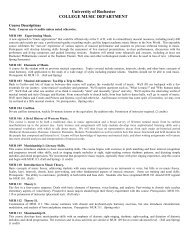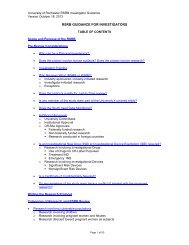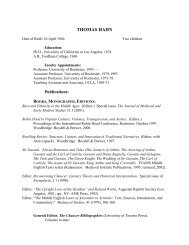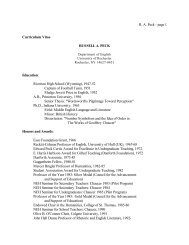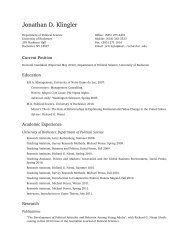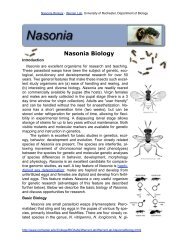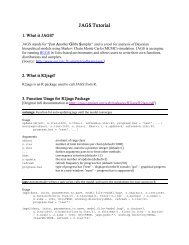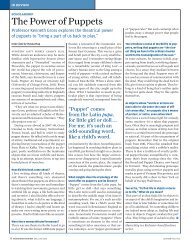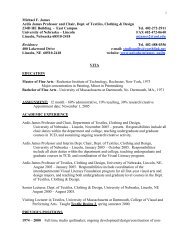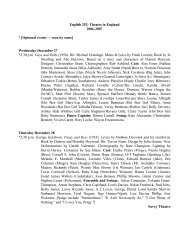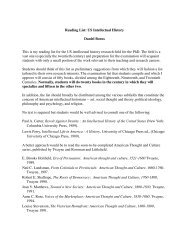In Review - University of Rochester
In Review - University of Rochester
In Review - University of Rochester
Create successful ePaper yourself
Turn your PDF publications into a flip-book with our unique Google optimized e-Paper software.
Protein Helps DNA Repair in Aging Cells<br />
scientists have long wondered<br />
why cells lose their ability to repair<br />
themselves as they age. Now<br />
research by <strong>Rochester</strong> scientists<br />
has uncovered two intriguing<br />
clues. DNa strands in human<br />
cells routinely break and repair<br />
themselves, but as cells age,<br />
the repair system becomes less<br />
A Brain-Cleansing Discovery<br />
a previously unrecognized<br />
system that drains waste from<br />
the brain has been discovered<br />
by neuroscientists at the Medical<br />
center. the highly organized<br />
system acts like a series <strong>of</strong> pipes<br />
that piggyback on the brain’s<br />
blood vessels, sort <strong>of</strong> a shadow<br />
plumbing system that seems to<br />
serve much the same function<br />
in the brain as the lymph system<br />
does in the rest <strong>of</strong> the body—to<br />
drain away waste products.<br />
“Waste clearance is <strong>of</strong> central<br />
importance to every organ,<br />
and there have been longstanding<br />
questions about how<br />
the brain gets rid <strong>of</strong> its waste,”<br />
says Maiken Nedergaard,<br />
the Frank P. smith Pr<strong>of</strong>essor<br />
<strong>of</strong> Neurosurgery and senior<br />
author <strong>of</strong> the research, which<br />
was published online in Science<br />
Translational Medicine. “this<br />
work shows that the brain is<br />
cleansing itself in a more organized<br />
way and on a much larger<br />
Photo ReseaRcheRs<br />
efficient, and flaws in the process<br />
lead to a decline in functionality<br />
and an increase in the incidence<br />
<strong>of</strong> tumors. to find out whether<br />
the process could be slowed or<br />
even reversed, biologists Andrei<br />
Seluanov, Vera Gorbunova, and<br />
colleagues found that the decline<br />
coincided with a global reduction<br />
scale than has been realized<br />
previously.<br />
“We’re hopeful that these findings<br />
have implications for many<br />
conditions that involve the brain,<br />
such as traumatic brain injury,<br />
alzheimer’s disease, stroke, and<br />
Parkinson’s disease,” she adds.<br />
Nedergaard’s team has dubbed<br />
the new system “the glymphatic<br />
system,” since it acts much like<br />
the lymphatic system but is<br />
managed by brain cells known as<br />
glial cells.<br />
scientists have known that<br />
cerebrospinal fluid plays an<br />
important role in cleansing brain<br />
tissue, carrying away waste<br />
products and carrying nutrients<br />
to brain tissue through a process<br />
known as diffusion. the newly<br />
discovered system circulates the<br />
fluid to every corner <strong>of</strong> the brain<br />
much more efficiently.<br />
“It’s as if the brain has two<br />
garbage haulers—a slow one<br />
that we’ve known about, and a<br />
fast one that we’ve just met,”<br />
says Nedergaard. “Given the high<br />
rate <strong>of</strong> metabolism in the brain,<br />
and its exquisite sensitivity,<br />
it’s not surprising that its<br />
mechanisms to rid itself <strong>of</strong><br />
waste are more specialized<br />
and extensive than previously<br />
realized.” —tom Rickey<br />
CLEANING UP: A newly recognized system in<br />
the brain seems to drain waste away much<br />
as the lymphatic system does for the body.<br />
in the levels <strong>of</strong> proteins involved<br />
in the repair process. the group<br />
tried to reverse the age-related<br />
decline by restoring the proteins<br />
to their original levels and found<br />
that only one protein, called<br />
sIRt6, proved effective. the<br />
work has been published in the<br />
Proceedings <strong>of</strong> the National<br />
Academy <strong>of</strong> Sciences. the team<br />
plans to study factors regulating<br />
sIRt6. seluanov says that multiple<br />
groups are trying to develop<br />
drugs that activate the protein,<br />
and he hopes the research will<br />
lead to therapies that help extend<br />
lifespans and treat cancer.<br />
—Peter Iglinski<br />
ARRESTING: Researchers have found a location in a gene <strong>of</strong> the flu<br />
virus that could be a “switch” to turn <strong>of</strong>f its ability to spread.<br />
Is There an ‘Off Switch’ for the Flu?<br />
<strong>Rochester</strong> scientists have helped<br />
identify a location in a gene <strong>of</strong><br />
the influenza a virus that could<br />
be used as a “switch” to disrupt<br />
the replication <strong>of</strong> the virus. If a<br />
way can be found to manipulate<br />
the switch in an organism, the<br />
researchers say it could have important<br />
implications for stopping<br />
the spread <strong>of</strong> the flu. conducted<br />
by Douglas Turner, pr<strong>of</strong>essor<br />
<strong>of</strong> chemistry, and colleagues<br />
Walter Moss, Lumbini Dela-<br />
Moss, and Salvatore Priore at<br />
<strong>Rochester</strong>, and chemists Ryszard<br />
Kierzek and elzbieta Kierzek at<br />
the Polish academy <strong>of</strong> sciences<br />
in Poznan, the work singled out<br />
messenger RNa, which is key to<br />
the production <strong>of</strong> two proteins<br />
the virus needs to propagate. to<br />
produce the second protein, the<br />
messenger RNa has to undergo<br />
the process <strong>of</strong> splicing, in which<br />
two remote sites <strong>of</strong> the long molecule<br />
join together, while the intervening<br />
segment is discarded.<br />
“We look at one <strong>of</strong> the splicing<br />
sites as a potential switch,” says<br />
turner. “If we can inactivate the<br />
switch to prevent the two sites<br />
from coming together, we can<br />
stop the virus from spreading.”<br />
the research was published in<br />
the journal PLoS ONE.<br />
—Peter Iglinski<br />
November–December 2012 ROCHESTER REVIEW 19




